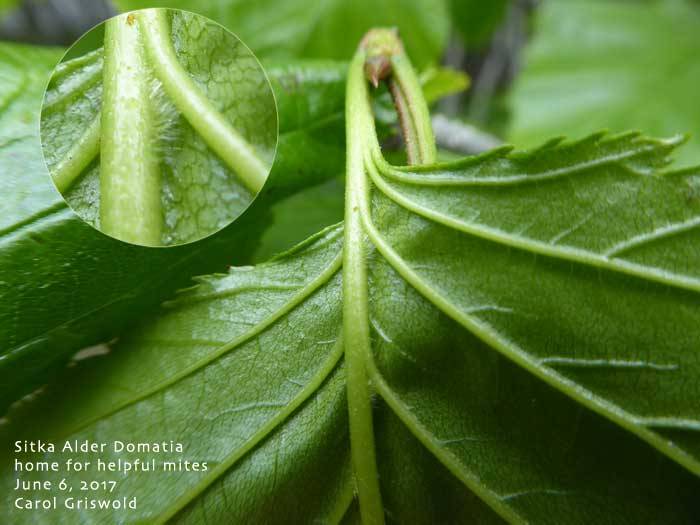One July day I was moseying along a streambank, looking at the alders. Both red and Sitka alders grew there, but I was focused on the Sitka alders; I examined many leaves and put a few into a plastic bag to take home. A passer-by asked if I intended to eat them. Well, no, to my knowledge, humans don’t eat alder leaves — I planned to inspect the under-surfaces of the leaves with a dissecting microscope in my study.
Whatever for? I suspect that most of my hiker friends already think I’m a bit nuts, with my interest in the composition of bear scats, the details of floral structures, the strange habits of slime molds, an unusual bird song, a skanky salmon carcass squirming with maggots, or other arcane natural history matters that often make me stop along a trail. A concern with the underside of alder leaves would probably clinch their opinions. Oh well.
I am interested in Sitka alder leaves because some of them have little tufts of hairs in the vein axils, where the side veins come off the midrib. On many other woody species in North America, including some maples, oaks, cherries and grapes, tiny structures in vein axils (usually tufts of hair in North America but often pits or pockets elsewhere) serve as domiciles for mites. They are called domatia (singular = domatium), which means “houses.” And they serve the functions of a house: mites retreat to them for shelter from environmental extremes and predators, to lay eggs, to defecate, and to molt (leaving their exoskeletons there). Years ago, by surveying many leaves of many species in the eastern forests of North America, we found that at least 25 percent of domatia (and often 50 percent) in most species showed signs of mite occupancy. Similar occupancy rates were also found in foliar domatia in many other parts of the world.
It is important to recognize that domatia are made naturally by the plant itself; they are often visible in the developing leaf bud. They are not galls, which are induced by the activities of insects or mites. So it is reasonable to ask if they serve a purpose and what that purpose might be.
Almost all of the mites we (and others) found in the domatia were potentially beneficial to the leaves and the plants that made them. Most of the mites were predatory—eating other mites or small insects — or fungus-eating — consuming molds and mildews and fungal filaments. Many studies have shown that the abundance of such beneficial mites is higher on leaves with domatia than on leaves without domatia. So the observations clearly suggest that this is a mutualistic relationship, in which both participants benefit: mites get housing in the domatia and plants get protection of their leaves.
The idea that the mite/domatia relationship is mutualistic dates back to 1887, when a Swedish scientist first looked at this. A few biologists accepted the idea without further investigation. But as is often the case with any new idea, the mainline scientists of The Establishment viewed the idea with scoffing, scorn, and rejection. Someone even went so far as to suggest that domatia occurred on leaves for the benefit of plant taxonomists, because they turned out to be useful in identifying species.
Such foolishness aside, a few experiments more than a hundred years later eventually showed that leaf damage is less when mites occupy the houses and forage over the leaf surfaces. Further study revealed that associations of mites with foliar domatia go back many millions of years, showing up in fossils. By now, leaf domatia are known from woody plants in most major taxonomic groups all around the world.
So — back to my Sitka alder leaves: I wanted to know if there were mites in those domatia too. I looked at 10 mature domatia-bearing leaves from each of five locations in Juneau, counted the domatia and inspected them for evidence of mites. In over 400 domatia, I found only four mites and one possible mite egg.
In the course of searching many alder leaves for domatia, I also found that leaves on many branches and trees had no domatia at all. In short, development of foliar domatia is sporadic in Sitka alders and mite occupancy is apparently very low. It takes a while for mite populations to develop on new leaves each year, so possibly a census of domatia in August would show a higher occupancy rate than in July, although that begs the question of what good it might do to protect leaves so close to the time when they turn brown and fall off. Maybe the summer season here is simply too short to allow time for a good population build-up of beneficial mites? Furthermore, considerations of mite population levels do not address the question of why domatia occur so sporadically on these leaves.
Perhaps evolution is in process of eliminating useless domatia from Sitka alders, or, contrarily, increasing their potentially useful occurrence on that species. Would on-going climate change affect the outcome? More questions than answers, once again!
• Mary F. Willson is a retired professor of ecology.

